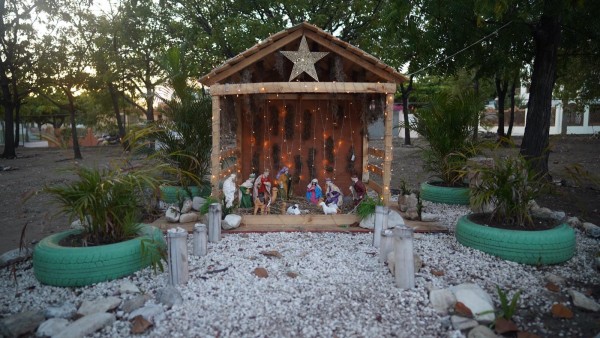
It is Christmas, and I have the privilege of spending this cheerful time in La Sagrada Familia Parish in Sabana Yegua , Dominican Republic, with my Community of Saint Paul family that lives and works here. I came just at the beginning of the Advent Season, during which we are called prepare ourselves to celebrate the birth of Jesus. And as part of this preparation, the church here is cleaned and decorated to evoke the anticipatory nature of the time before Christmas. As one would expect, part of the decoration is the Nativity set, for which a wooden house has been built. Inside there are the usual suspects: Joseph, Mary, the donkey, the ox, the shepherds, the Magi, the star and the angel; baby Jesus is, of course, “hidden” until midnight on Christmas Eve.
The imagery of the Nativity, or Creche, captures the two Christmas stories we have in the Gospels of Luke and Matthew. That is right, we have two Christmas stories, and we use them as if they were one. The shepherds are only in Luke’s account, while the Magi are in Matthew’s story. The star is only in Matthew, while the angels are part of Luke’s narrative. But when we built our Nativity set, we blend all the elements to reconstruct the familiar image we have known since we were children, including that one sheep that is missing a leg and we spend the whole season trying to make it stand. After some time contemplating our Nativity set here in Sabana Yegua, I asked myself, why do we need two Christmas stories?
Matthew and Luke are the only two gospels that tell us about the birth of Jesus. Matthew 1:18-2:23 tells us the story from Jesus’s birth in Bethlehem to the flight to Egypt and his come back to Nazareth where he grew up. In these few verses, we are told how the Holy Family starts with the shameful situation of Mary being pregnant, but not from her future husband. This is certainly a problem in a small town, and most probably a penalty paid with death. Nevertheless, Joseph is advised to proceed with the wedding and take Mary to his home. When Jesus is born, he is manifested to foreigners, that is the Magi, not to his own people, and even less to the religious leaders of that time. After this, they face persecution and emigrate to Egypt where Jesus escapes death.
Alternatively, Luke does not tell us about Jesus birth but until the second chapter, and in 40 verses he describes the birth, manifestation to the shepherds and also to two elderly people in the Temple. Luke is the one telling us of the struggles of the Holy Family to find shelter and a place to stay in Bethlehem. The image of the manger is found in Luke’s narrative and the revelation of Jesus to the shepherds is a the parallel to the Magi in Matthew. Again, in Luke, the son of God is not revealed to the religious leaders but to the humble shepherds.
The two different accounts are united in two fascinating insights: first, the Holy Family started with serious struggles; far from being a “perfect” family, they had a rough beginning. And second, the revelation of Jesus was first to people no one expected. Both Matthew and Luke agree in establishing Jesus’ origins as a critique to conventionalism. That is precisely what the Nativity set is; it is a symbol of what is unconventional. The poor, the stranger, the foster father, the manger… all of it speaks against the ideal situations we have created in society and in favor of realities and lives that many people strive to avoid. Nonetheless, this was the reality of Jesus’ birth. We have created molds and ideals that are almost impossible to attain, from a big house, the perfect family, to the ideal body, etc., believing that this is the only way that we can be fulfilled. We also have become a society that often rejects the immigrant and continues to forget about the poor. We live our lives chasing conventions which social media has promoted and falsely advertise as the “norm,” and when we do not attain them, we fall under the heavy weight of anxiety and failure.
That is why I believe we need both Christmas stories which are represented in the Nativity set. In a society of conventions and ideals, two stories that speak in different ways about the unconventional birth of Jesus offer us an unconventional reality. Hopefully, when we look at the Nativity set, we feel invited to free ourselves from any mold, expectation or idea of a “perfect” life we may have created as a yoke for ourselves.









